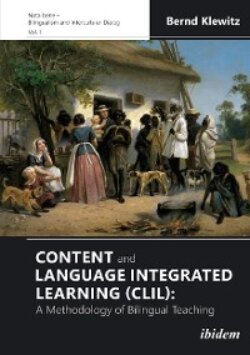Читать книгу Content and Language Integrated Learning (CLIL): A Methodology of Bilingual Teaching - Bernd Klewitz - Страница 10
1.5 The Dual System Hypothesis
ОглавлениеWhether this can also be seen as a confirmation of the Dual System Hypothesis (DSH; cf. Meisel: 48), also called Dual Language System Hypothesis (cf. Genesee 1996) is open to debate, but at least it hints at further differences in linguistic knowledge and performance between monolinguals and bilinguals—that are useful to know when it comes to study CLIL performance in more detail. The DSH proposes the
idea of early differentiation of linguistic systems, characteristic of the developmental pattern through which simultaneous bilinguals typically proceed … a hypothesis widely accepted today on the basis of findings obtained by a steadily increasing number of case studies carried out over the past 30 years (Meisel: 48, 72).
According to the proponents of the DSH, bilingual children acquire two different language systems from the beginning of language acquisition, which as a process results in two distinct mental grammars (cf. Meisel: 52); their rules do not cross over from one language to the other (cf. Bradley: 2020 n.p.) without denying a linguistic interaction between the two systems. Interaction would occur “primarily in settings where one language is dominant and the other one weak, either in the social context or in the mind of speakers” (Meisel: 53). Since bilingual programs like CLIL inevitably have to deal with a stronger (L1) and a weaker language (L2), this would have a number of consequences for teaching strategies and learning processes, which are discussed when looking at CLIL tools and skills (cf. chapter 8). But despite this assumption based on observation and common sense the terms “strong” and “weak” need some qualification:
Empirical justifications for qualifying a language as ‘weak’ or as ‘non-dominant’ commonly refer to one or more of the following observations: a) The language in question is rarely or not at all used actively; b) the other language is strongly preferred; c) the development of the allegedly weak language is less advanced than that of the other language (ibid.: 130).
The strong point pertinent to the DSH is, then, that bilingual children do not move through stages to be eventually able to distinguish between two languages. On the contrary, they are able to have two language systems and are aware which system is related to which language (cf. Bradley: 2020 n.p.). There are recent studies that ascertain bilinguals’ capacity to use the correct system for each language without “mixing” them, and an individual’s capability to differentiate which language is spoken—Ava’s example comes to mind—and a test showing that bilingual children responded with the same language spoken to them (cf. ibid. and Genesee: 1996).
This shows us that bilingual children under the age of two could differentiate the language being heard and respond with the same language, which supports the idea that children have two different language systems (Bradley: 2020 n.p.).
How code-switching and the concept of interlanguage can be accounted for is part of the challenges still connected with CLIL and dealt with in a final look at desiderata of this approach (chapter 10).
Overall and also according to the MHH-Review, studies provided a mixed and complex picture in terms of the relationship between mother tongue (L1) and the foreign language (L2) acquired. Established was some transfer from L1 to L2 and vice versa and hence the existence of two language systems, not independent but inter-connected. The question of a unitary phonological system was regularly abandoned in favor of the evidence of two separate systems by a majority of the studies reviewed. The observation that phonemes are shared in both languages was substantiated by the experience that they are acquired in one language before another. This interconnectedness does not only account for the fact that researchers found robust evidence for transfer from the dominant language to the language acquired later (L1 to L2), but was also mirrored by the existence of only two older studies (from the 1970s and 1980s) arguing for a unitary language system. This is to say that empirical data help to determine the validity of language acquisition theories of past and present to a degree that is relevant for teaching bilingual programs at schools.
